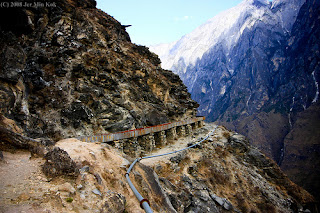Chapter Two
Tiger Leaping Gorge: Leaping tiger of water
Tiger Leaping Gorge locates about 100 kilometers (62 miles) northwest of Lijiang Old Town and lies between Jade Dragon Snow Mountain and Haba Snow Mountain).--It is the longest, deepest, and narrowest gorge in the world.
Sights of Tiger Leaping Gorge
From the top of the gorge you look down the steeply angled (70-90 degrees) mountain sides to the rushing Golden Sands (Jingsha) River with its 18 frothing rapids more than 200 meters (about 700 feet) below.
Naturally divided into three sections, the first section, which is the narrowest and uppermost section, is the mouth of the fast flowing Jingsha River. In the midst of the river's mouth is a large rock that is positioned at the gorge's narrowest section-only 30 meters (33 yards) wide.
 |
| Tiger Leaping Gorge |
An ancient legend says that a tiger used this rock as its stepping stone so it could leap across from one side of the gorge to the other, which is how the gorge got its name.
As the river enters the middle section, it drops another 100 meters (330 feet) and its flowing rate increases to an amazing speed. Here the thunderous rushing waters slam into sharp, large rocks and crash down into the river forming swirling whirlpools. Can it get more exciting? Yes, it can as the third and lowest section is acclaimed for being the wildest attraction of all!
The cliffs over-looking this section are even steeper and much more dangerous. Here, the river twists and turns and the river vigorously surges forward creating high waves and a frothy spew as it collides with the mountainsides. This is a view that inspires a sense of adventure and satisfies the deepest yearnings for magnificent scenery.
The gorge stretches about 15 kilometers (nine miles) and also affords people the possibility of rafting and drifting peacefully in its large quiet sections, for the gentler folks among us and an exciting rafting adventure for the more experienced. Do not want to raft?
Useful Tips: This is a great sightseeing stop with enormous photo opportunities. Bring your camera, wear skid-proof shoes, and be prepared to be astonished.
Navigate Tiger Leaping Gorge
The inhabitants of the gorge are primarily the indigenous Naxi people, who live in a handful of small hamlets. Their primary subsistence comes from grain production and foreign hikers. The gorge is not considered navigable. In the early 1980s, four rafters attempted to go down the gorge and were never seen again. In 1986, the first known successful attempt to sail through the gorge was made by the first expedition to float down the entire length of the Yangtze, starting at the river's high source at the Gelandandong glacier lake.
 |
| The Hiking Path |
Moreover, the hiking path ("the high road") is well-maintained and marked, although sometimes narrow, and is used by the Naxi as part of everyday life. This trail is longer than the lower road, approximately 22 kilometers, but more varied. It features a variety of micro-ecosystems, waterfalls, and a fair number of guesthouses for trekkers. These guesthouses are not well heated, which combined with the unpredictable nature of high mountain weather makes this trek unadvisable during the rainy season, although in recent years the raining periods got shorter and it got possible to hike there again.
 |
| Horses |
However, some locals in Lijiang will insist that this hike is dangerous, especially in rainy season. You must not go when it is pouring, or if there has been a huge amount of recent rain due to the threat of landslides. But if it hasn't been that wet lately, and you find a couple of dry days and are reasonably experienced at hiking, the worst that will happen is that you will get muddy and have to ford a couple of swollen cascades. “Safety First” is what you should always keep in mind.
--Splendid Tiger Leaping Gorge is a great place for you to experience the power of the nature. Don’t hesitate anymore, believe me, you’ll be shock and hardly find out an exact word to describe its natural brilliant!

No comments:
Post a Comment
Thanks for your comment and welcome to China!